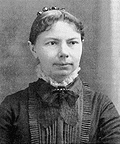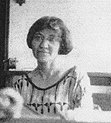|
Women
in Meteorology Before World War II
Before
the middle of the Nineteenth Century, formal education of girls and
women was nearly non-existent in both the United States and Europe.
Women were expected to become wives and mothers, and any education was
toward that end. Even in the early days of the education of women, most
were educated only in religion, singing, dancing, and literature, to
improve them in their future roles in the traditional family. A few
outstanding women surpassed the expectations of the day to become noted
atmospheric scientists.
A few other women worked to extend the boundaries
of what was expected of women by teaching atmospheric sciences to younger
women. The only socially acceptable occupation for women at the time
was teaching, and only unmarried women could be teachers. Among the
women described below, very few married. They began training women in
traditionally male disciplines including science and mathematics, thus
laying the groundwork for women meteorologists of the Twentieth Century.
 |
|
Sarah Frances Whiting (Courtesy
Wellesley College Archive)
|
Sarah Frances
Whiting (1847-1927)
Sarah Frances
Whiting was born in Wyoming, NY, the daughter of Elizabeth Comstock
and Joel Whiting. Her father was a graduate of Hamilton College and
held a number of teaching positions around New York State. She became
interested in physics while helping her father prepare demonstrations
for his classes. She was given no formal education, but was tutored
in mathematics and physics by her father.
She graduated with a bachelor's degree from Ingham
University in Le Roy, NY, in 1865. She taught at the Brooklyn Heights
Seminary for girls until 1876. While there, she attended scientific
lectures and visited laboratories in the area.
In 1875, Henry Fowle Durant, founder of Wellesley
College, sought her to teach phys-ics at his new school. Upon moving
to the Boston area, she attended the laboratory phys-ics classes of
Edward C. Pickering at the Massachusetts Institute of Technology. This
laboratory was the first undergraduate physics laboratory in the United
States. In 1878, Whiting opened the second undergraduate physics lab
in the United States at Wellesley College. In 1895, when Roentgen's
discovery was announced, she assembled the equip-ment and made the first
X-ray photographs in the United States.
She was the first woman invited to join the New England
Meteorological Society and initiated a course in meteorology. She assembled
a meteorological observing station, and her students collected data
for the U.S. Weather Bureau, since there were no other observ-ing stations
nearby. However, she was most famous for her work with the spectroscope
and for her astronomy class which she taught for 20 years with little
equipment. In 1900, Mrs. John C. Whitin made funds available for the
Wellesley Observatory with a 12-inch refracting telescope, spectroscopic
lab, and photometer.
During her travels, she met many other great scientists
of the day. In an article in Science, she remarked of Lord Kelvin that
"in contrast to many other...scientists, Sir William seemed neither
surprised nor alarmed that a woman should devote herself to mathematics
and physics." Whiting was a member of the American Physical Society
which, at first, refused to invite women to its banquets. She was one
of five women at the time to be elected a fellow of the American Association
for the Advancement of Science. In 1905, she received an honorary degree
from Tufts College for her contributions to teaching. Her legacy is
not that of a researcher, but as a great and inspiring teacher.
Shearer, Benjamin F, and Barbara S. Shearer, 1997:
Sarah Frances Whiting. Notable Women in the Physical Sciences, a biographical
Dictionary.
Grace Evangeline
Davis (1870-1955)
Grace Evangeline Davis was born 6 June, 1870, in
North Chelmsford, MA. She stud-ied physics and meteorology under Sarah
Frances Whiting at Wellesley College, receiving a B.A. in 1898 and M.A.
in 1905. She was associate professor of physics at Wellesley 1899 -
1936, and was most famous for her course in meteorology. She later studied
at Radcliffe College, Harvard College, and the Massachusetts Institute
of Technology. She was a charter member of the American Meteorological
Society. She died 15 April, 1955.
Mary Murray Hopkins
(?-1921)
Mary Murray Hopkins was Professor of Astronomy at
Smith College, Northampton, MA, from 1906 until her untimely death by
her own hand in 1921. She received her M.S. from Smith in 1912, and
a Ph.D. from Columbia University in 1915. She spent two years at the
Yerkes Observatory in Chicago, and was a charter member of the American
Meteo-rological Society.
 |
|
Eleanor Anne Ormerod, LLD, FRMet.
S., first woman honorary graduate of the University of Edinburgh,
from an oil painting honoring her doctorate (courtesy Royal Meteorological
Society)
|
Eleanor Anne
Ormerod (1828-1901)
Eleanor Ormerod was born 11 May 1828 at Sedbury Park,
Gloucestershire, five years younger than her next eldest sister and
collaborator Georgiana. She received a general education from her mother
as was the custom of the time. She learned to speak and write in English,
French, Latin, Italian, Spanish, Dutch and Norwegian, and became an
accomplished illustrator, a skill she used in her published works.
She began her scientific study in 1852 after finding
a rare locust on the grounds of the family estate. Eleven years later,
she bought herself a microscope, and began her observations. In 1868,
she answered a call by the Royal Horticultural Society to investigate
which insects were gardeners' friends and which were pests, and for
this work, the RHS awarded her a Silver Medal. However, this work was
not approved by the elders of the family, so not until her father's
death in 1873 could she begin her work as a serious scientist.
In 1873, she moved to Torquay, near where her brother,
George Wareing Ormerod was taking meteorological observations. He ran
the station from 1874 to 1883 and became a Fellow of the Royal Meteorological
Society in 1874. It was here that Eleanor first took interest in meteorology
and its relationship to insects.
In 1876, Eleanor and Georgiana moved to Spring Grove,
Isleworth, Middlesex, near Kew Gardens where her friend, Joseph Hooker,
was director. During this most prosperous period, she published a number
of manuscripts, and, in 1877, became the first woman Fel-low of the
Royal Meteorological Society. On the forms, all appearances of the word
"him" were scratched out, replaced with "her."
In the next few years, she set up her own meteorological
station at Isleworth, published a number of manuscripts in the Quarterly
Journal of the Royal Meteorological Society, and collated decades of
observations from other weather stations. She wrote annual reports on
insects, with a circulation of 170 000 worldwide. She was appointed
to the unpaid post of Consulting Entomologist for the Royal Agricultural
Society. Other honors include the gold Victoria Medal of Honour of the
Royal Horticultural Society, and the first woman to receive an LLD from
the University of Edinburgh. She died at St. Albans on 20 July 1901.
Wood, M., 1999: Meteorologist's profile - Eleanor
Anne Ormerod. Weather, 54, 365,369.
Caterina Scarpellini
(1808-?)
Caterina Scarpellini was a meteorologist in Rome
during the middle 19th Century. In 1859, she founded the Meteorological
Ozonometric Station in Rome. She kept careful records of weather and
ozone conditions in Rome for a number of years, and published a number
of manuscripts on ozone and coastal squalls observed at her station.
Also an astronomer, she is credited with the discovery of a comet in
1854. She was awarded a gold medal by the new government of Italy in
1872 for her work in statistics.
 |
|
Gladys Wrigley in 1923 (Courtesy
American Geographic Society)
|
Gladys Wrigley
(1855-1974)
Gladys Wrigley was born 14 September, 1885) in York,
England. She achieved a degree in geology from the University College
of Wales in Aberystwyth in 1907, and taught at a girls' school in Wales
for the next four years. She earned a fellow-ship to Yale University,
which she attended 1911-1917, and became the first woman in the United
States to earn a Ph.D. in geography with her work on the Roads and Towns
of the Central Andes.
She began working at the American Geographical Society
after leaving Yale, and in 1920 was became the first Editor of Geographical
Review, the Society's principal publication, and held that position
until her retirement in 1949. She was one of the most influential scientific
editors of the first half of the 20th Century. Under her leadership,
the Review presented research of high intellectual quality in a broadly
accessible style. She never shied from rejecting articles from even
the most influential geographers, nor from her bosses at the Society.
For this work, she was awarded the first Association of American Geographers
Outstanding Achievement Award in 1951, and the Geographical Society
of Chicago Award in 1948.
Despite having one of the most important positions
in the Society, she was never invited to dine with councilors of male
staff members. While male geographers with Ph.D.s were addressed "Dr.,"
she was always referred to as "Miss Wrigley." She was a very private
person, and few photographs of her are known to exist. She was a charter
member of the American Meteorological Society.
Fairchild, W. B., 1976: Gladys Mary Wrigley 1885-1975.
Geographical Review, 66,331-333. McManis, Douglas R., 1990, The editorial
legacy of Gladys M. Wrigley. Geographical Review,80, 169-181.
Eleanor Stabler
Brooks (1892-1986)
Eleanor Stable Brooks was the wife of Charles S.
Brooks, one of the founders of the American Meteorological Society,
and was herself a noted meteorologist. She was born 27 September, 1892,
in Falmouth, NY. She attended Radcliffe College, receiving a B.A. in
Botany in 1914. At Radcliffe, she won the Captain Jonathan Fay Prize,
Radcliffe Col-lege's highest undergraduate honor presented annually
to the graduating senior woman who "has given evidence of the greatest
promise" by her scholarship, conduct, and character. She worked as a
meteorologist at the Blue Hill Observatory from 1933-1957, and as an
indexer for the Bulletin of the American Meteorological Society for
ten years beginning in 1950. With her husband, she co-wrote a popular
daily article on the weather for daily newspapers, "Why the Weather?,"
which was collected into a book in the late 1920s. She died 28 February,
1986, in Falmouth, ME. She and her sister, Anna Bunker Stabler (1901-1991)
were charter members of the American Meteorological Society. She is
the only woman presented here who married and had children.
Mary Lanier (1872-1961)
Mary Jean Lanier was born 10 July, 1872, in Nashville,
TN. She achieved a B.S. in 1909, and Ph.D. in 1924, in Geography, from
the University of Chicago. She taught geography at Toledo (Ohio) University
(1909-1910) and at the Universi-ty of Chicago (1910-1917). She became
professor of Geology and Geography at Wellesley College in 1917, and
headed the Geography Department (1927-1939). She was a charter member
of the American Meteorological Society. She lived with Professor Seal
Thompson, professor of Biblical Studies, during her time at Wellesley.
She died in Wellesley 23 April, 1961.
Frances E. Knowlton
Chickering
Little is known of this woman except her book Cloud
Crystals; A Snow-Flake Album, published in 1864, in which she presents
drawings of different forms of snowflakes, along with some atmospheric
conditions accompanying each. Though an amateur, she was a keen observer
and intuitive theorist of the time.
Mergen, Bernard, 1997: Snow in America. Smithsonian Institution
Press, 321 pp.
|


